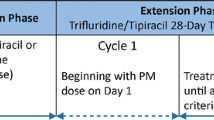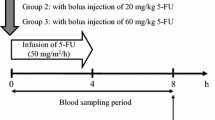Abstract
Purpose: The purpose of this investigation was to evaluate the efficacy of oral 5-(phenylselenenyl)-acyclouridine (PSAU) in increasing endogenous plasma uridine concentration as well as its ability to improve the bioavailability of oral uridine. PSAU is a new potent and specific inhibitor of uridine phosphorylase (UrdPase, EC 2.4.2.3), the enzyme responsible for uridine catabolism. This compound was designed as a lipophilic inhibitor in order to facilitate its access to the liver and intestine, the main organs involved in uridine catabolism. Methods: Oral PSAU was administered orally to mice alone or with uridine. The plasma levels of PSAU as well as uridine and its catabolites were measured using high-performance liquid chromatography and pharmacokinetic analysis was performed. Results: PSAU has an oral bioavailability of 100% and no PSAU metabolites were detected. PSAU has no apparent toxicity at high doses. Oral administration of PSAU at 30 and 120 mg/kg increased baseline concentration of endogenous plasma uridine (2.6 ± 0.7 μM) by 3.2- and 8.7-fold, respectively, and remained three- and six-fold higher, respectively, than the controls for over 8 h. PSAU, however, did not alter the concentration of endogenous plasma uracil. Co-administration of PSAU with uridine elevated the concentration of plasma uridine over that resulting from the administration of either alone, and reduced the peak plasma concentration (C max) and area under the curve (AUC) of plasma uracil. Co-administration of PSAU at 30 mg/kg and 120 mg/kg improved the low bioavailability of oral uridine (7.7%) administered at 1320 mg/kg by 4.8- and 4.2-fold, respectively, and reduced the AUC of plasma uracil from 1421 to 787 μmol/h · l and 273 μmol/h · l, respectively. Similar results were observed when PSAU was co-administered with lower doses of uridine. Oral PSAU at 30 mg/kg and 120 mg/kg improved the bioavailability of oral 330 mg/kg uridine by 5.2- and 8.9-fold, and that of oral 660 mg/kg uridine by 6.4- and 9.0-fold, respectively. However, the reduction in the AUC values of plasma uracil was less dramatic than that seen when the high dose of 1320 mg/kg uridine was used. Conclusion: The effectiveness of the PSAU plus uridine combination in elevating and sustaining high plasma uridine concentration may be useful to rescue or protect from host toxicity of various chemotherapeutic pyrimidine analogs as well as in the management of medical disorders that are remedied by administration of uridine.
Similar content being viewed by others
Author information
Authors and Affiliations
Additional information
Received: 4 August 1999 / Accepted: 19 November 1999
Rights and permissions
About this article
Cite this article
Ashour, O., Al Safarjalani, O., Naguib, F. et al. Modulation of plasma uridine concentration by 5-(phenylselenenyl)acyclouridine, an inhibitor of uridine phosphorylase: relevance to chemotherapy. Cancer Chemother Pharmacol 45, 351–361 (2000). https://doi.org/10.1007/s002800051002
Issue Date:
DOI: https://doi.org/10.1007/s002800051002




